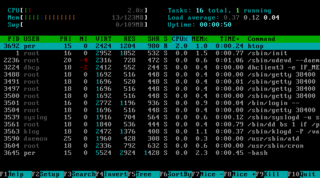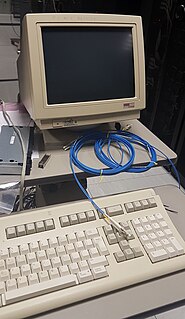Related Research Articles

ASCII, abbreviated from American Standard Code for Information Interchange, is a character encoding standard for electronic communication. ASCII codes represent text in computers, telecommunications equipment, and other devices. Most modern character-encoding schemes are based on ASCII, although they support many additional characters.
In computing and telecommunication, a control character or non-printing character (NPC) is a code point in a character set, that does not represent a written symbol. They are used as in-band signaling to cause effects other than the addition of a symbol to the text. All other characters are mainly printing, printable, or graphic characters, except perhaps for the "space" character.
In computing and telecommunication, an escape character is a character that invokes an alternative interpretation on the following characters in a character sequence. An escape character is a particular case of metacharacters. Generally, the judgement of whether something is an escape character or not depends on the context.

A terminal emulator, terminal application, or term, is a computer program that emulates a video terminal within some other display architecture. Though typically synonymous with a shell or text terminal, the term terminal covers all remote terminals, including graphical interfaces. A terminal emulator inside a graphical user interface is often called a terminal window.

The VT100 was a video terminal, introduced in August 1978 by Digital Equipment Corporation (DEC). It was one of the first terminals to support ANSI escape codes for cursor control and other tasks, and added a number of extended codes for special features like controlling the status lights on the keyboard. This led to rapid uptake of the ANSI standard, which became the de facto standard for hardware video terminals and later terminal emulators.

ANSI escape sequences are a standard for in-band signaling to control cursor location, color, font styling, and other options on video text terminals and terminal emulators. Certain sequences of bytes, most starting with an ASCII escape character and a bracket character, are embedded into text. The terminal interprets these sequences as commands, rather than text to display verbatim.

A computer terminal is an electronic or electromechanical hardware device that can be used for entering data into, and transcribing data from, a computer or a computing system. The teletype was an example of an early day hardcopy terminal, and predated the use of a computer screen by decades.

The VT220 is a computer terminal introduced by Digital Equipment Corporation (DEC) in November 1983. The VT240 added monochrome ReGIS vector graphics support to the base model, while the VT241 did the same in color. The 200 series replaced the successful VT100 series, providing more functionality in a much smaller unit with a much smaller and lighter keyboard. Like the VT100, the VT200 series implemented a large subset of ANSI X.364. Among its major upgrades was a number of international character sets, as well as the ability to define new character sets.

The tab keyTab ↹ on a keyboard is used to advance the cursor to the next tab stop.

In computing, text-based user interfaces (TUI), is a retronym describing a type of user interface (UI) common as an early form of human–computer interaction, before the advent of graphical user interfaces (GUIs). Like GUIs, they may use the entire screen area and accept mouse and other inputs. They may also use color and often structure the display using special graphical characters such as ┌ and ╣, referred to in Unicode as the "box drawing" set. The modern context of use is usually a terminal emulator.
A tab stop on a typewriter is a location where the carriage movement is halted by an adjustable end stop. Tab stops are set manually, and pressing the tab key causes the carriage to go to the next tab stop. In text editors on a computer, the same concept is implemented simplistically with automatic, fixed tab stops.

The VT50 was a CRT-based computer terminal introduced by Digital Equipment Corporation (DEC) in July 1974. It provided a display with 12 rows and 80 columns of upper-case text, and used an expanded set of control characters and forward-only scrolling based on the earlier VT05. DEC documentation of the era refers to the terminals as the DECscope, a name that was otherwise almost never seen.
The LK201 was a detachable computer keyboard introduced by Digital Equipment Corporation of Maynard, Massachusetts in 1982. It was first used by Digital's VT220 ANSI/ASCII terminal and was subsequently used by the Rainbow-100, DECmate-II, and Pro-350 microcomputers and many of Digital's computer workstations such as the VAXstation and DECstation families.

On computer keyboards, the enter key⌅ Enter and return key↵ Return are two closely related keys with overlapping and distinct functions dependent on operating system and application.

The Gold key is a computer keyboard key used as a prefix to invoke a variety of single-key editing and formatting functions. Usually located in the top-left position of the numeric keypad on platforms such as the VT100, it is the signature element of a consistent user interface implemented by Digital Equipment Corporation across multiple product lines.

DECmate was the name of a series of PDP-8-compatible computers produced by the Digital Equipment Corporation in the late 1970s and early 1980s. All of the models used an Intersil 6100 or Harris 6120 microprocessor which emulated the 12-bit DEC PDP-8 CPU. They were text-only and used the OS/78 or OS/278 operating systems, which were extensions of OS/8 for the PDP-8. Aimed at the word processing market, they typically ran the WPS-8 word-processing program. Later models optionally had Intel 8080 or Z80 microprocessors which allowed them to run CP/M. The range was a development of the VT78 which was introduced in July 1977.
A six-bit character code is a character encoding designed for use on computers with word lengths a multiple of 6. Six bits can only encode 64 distinct characters, so these codes generally include only the upper-case letters, the numerals, some punctuation characters, and sometimes control characters. The 7-track magnetic tape format was developed to store data in such codes, along with an additional parity bit.

The VT520 is an ANSI standard computer terminal introduced by Digital Equipment Corporation (DEC) in 1993 and 1994. The VT520 is a multi-session monochrome text-only terminal with a built-in 14" monitor. The VT510 was a single-session version, while the VT525 added color support and used a separate external monitor.

The VT320 was an ANSI standard computer terminal introduced by Digital Equipment Corporation (DEC) in 1987. The VT320 was the text-only version, while the VT330 added monochrome ReGIS, Sixel and Tektronix 4010 graphics, and the VT340 added color.
EDT is a character-based text editor from Digital Equipment Corporation (DEC) running on PDP-11, and later for its OpenVMS operating system. It can respond to single keystrokes, and uses function keys to implement commands to the editor. EDT was introduced originally as a line-mode editor. The screen mode was developed first as the Keyboard Editor (KED) on RT-11 as part of the FMS-11 project by Darrell Duffy; EDT on the other operating systems was then enhanced to be compatible with KED.
References
- ↑ digital equipment corporation (December 1978). WPS-8 Word Processing System Reference Manual (Versions 2.7 and 3.0) (PDF). Retrieved Sep 1, 2016.
- ↑ Page 53, Overload!: How Too Much Information is Hazardous to Your Organization, By Jonathan B. Spira, ...I spoke with Dan Bricklin, the co-inventor of VisiCalc, who was on the team at DEC that developed WPS-8 in the mid-1970s......which ran on the DEC 310w, a special version of the DEC 310 which had a video display terminal...